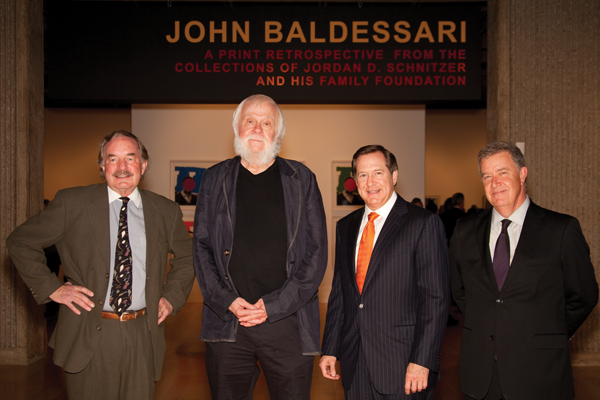Jordan Schnitzer

BY KIMBERLY NICHOLS
When noted art collector Jordan Schnitzer was a young boy his mother Arlene Schnitzer opened the Fountain Gallery in Portland, Oregon to spotlight artists in the Pacific Northwest. Her staunch belief in supporting artists from the region carried down to her son who, at 14 years of age, bought his first painting —a canvas by Louis Bunce titled Sanctuary.
“I wrote on the back of it ‘bought on the night of June 23rd, 1965: the first piece of the Schnitzer Collection’ and have never looked back,” says Jordan.
As an adult, his scope of interest expanded to cover major contemporary artists of our time including Jim Dine, Frank Stella, David Hockney, Tom Wesselman and many others.
“My first love was art of the Northwest,” says Jordan. “Today, I am attracted to art that fits in one of three categories. First is work that makes me laugh, such as William Wegman putting a dog in a baseball outfit. This is the kind of work that makes us pinch ourselves and teaches us not to take life too seriously. Secondly, I love work that is bright and masterful in color like that of Joseph Albers and Sam Francis. Thirdly, I love work that intellectually grabs me and won’t let me go —art that forces me to deal with my preconceived notions about things concerning stereotypes, values, society and the themes of our times. For example, work by artists like Warhol and Lichtenstein that made us deal with the Media Age and mass marketing.”
The focus of his collecting mission gradually narrowed to a primary concern with compiling serious retrospectives of prints and multiples by world-renowned artists. Today this collection comprises more than 7,000 pieces. When asked about why he is compelled to collect prints rather than original paintings or other works by artists, Jordan’s answer is admirable, and all about injecting a passion for art into public consciousness.
“People like Eli Broad are already doing a fine job of amassing contemporary art collections,” he says. “But I like walking into the mind of singular artists, learning all about what’s inside there, and amassing a retrospective- sized number of pieces that stem from that mind to share with the world.”
His first loan to a museum was at the Jordan Schnitzer Museum of Art at the University of Oregon where he not only received his undergraduate degree but also served on its board for 26 years. When he walked into the exhibition on opening night he didn’t think anything could be better than watching the guests ooh, ahh, laugh and frown, going through all the emotions that occur when looking at art. He became committed to lending works to museums and other institutions willing to allow members of the general public to experience art that they might not ordinarily be able to see.
For the last twenty years, the Schnitzer Collection has spawned over 80 exhibitions that have traveled to 50 different museums. Recently, the Palm Springs Art Museum enjoyed the fruits of Schnitzer’s John Baldessari print retrospective.
“As a successor to the Surrealists of decades ago, Baldessari is brilliant at taking appropriated images that mayseem familiar to us at first glance, and completely changing them so that we question our own version of reality,” says Jordan. “His work defies us to think about all the information we have access to in this day and age and come to realize that we may not be any smarter or wiser because of it. His colors make me emotionally soar and, intellectually, they drive me crazy.”
Baldessari says that he likes knowing Jordan is out there collecting his work. “I met him at one of the Art Basel Fairs and was curious about someone who only collected prints and so in depth. Although I don’t think it’s a requirement to have relationships with all of my collectors, when it happens it can be quite fruitful and I’ve enjoyed knowing him.”
Although personal ties to museums aren’t a prerequisite for Jordan’s generous lending of a show, he does have a love for the small Palm Springs Art Museum, an institution currently enjoying expansion into a force to be reckoned with under the Directorship of Dr. Steven Nash. Jordan spent much of his young life staying in the desert and now has a second home there.
One thing that makes the lending of his collections to museums unique is that he also funds peripheral items relevant to the exhibitions, like advertising and marketing, the procurement of school buses to give local children the opportunity for field trips to the museum, and events gener- ated around the exhibitions to help raise supporting funds.
Even with all of his philanthropic efforts towards the world of art and culture, Jordan stands out as a rare donor because his over- whelming love of art outshines any sense of a projection of personal ego.
“There is no sense of ownership in my art as I feel very much a steward of the work and a facilitator between these brilliant artists and the wonderful institutions that mount these shows so that we, the public, can share in the experiences that art brings to our lives,” he explains.
The bottom line in his giving is the impulse to share art with the world, especially with those of its denizens who may, with one visit to an exhibition, find their lives transformed.


